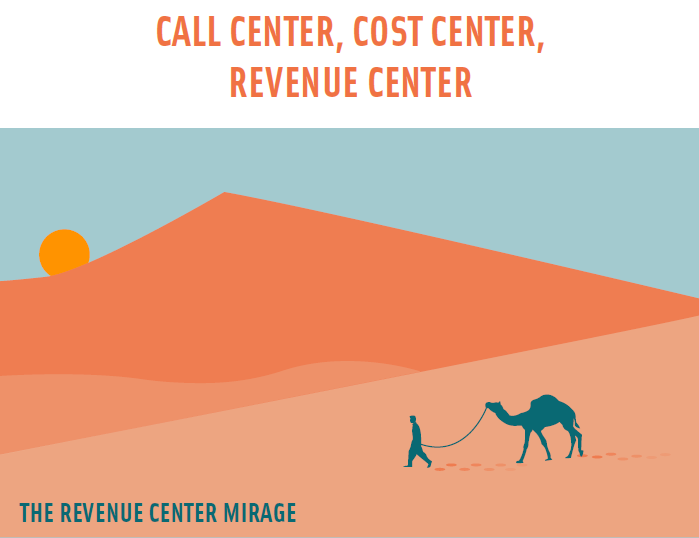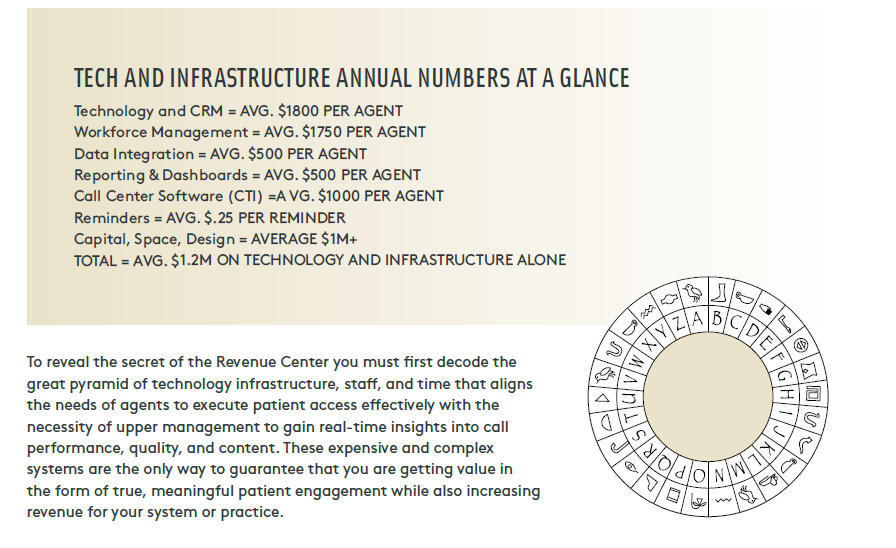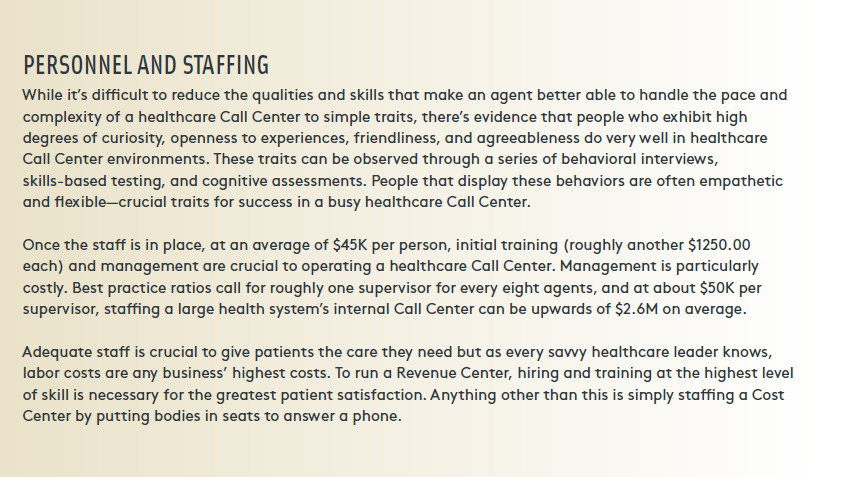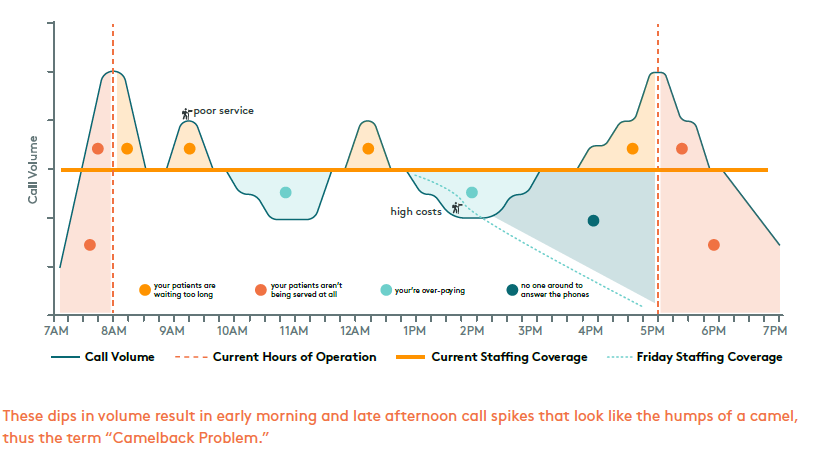CALL CENTER,COST CENTER, OR REVENUE CENTER?
The Revenue Center Mirage
Pressed for Time?
Watch the video to the right and get this white paper content in under 5 minutes— then come back for a deeper dive into our findings by scrolling to the full version below. Or let Haxall know you would like to download a pdf version for later."

CONSIDERING AN INTERNAL HEALTHCARE CALL CENTER BUILD?
We often hear from our partners across the industry that they struggle with balancing the modern demands of care delivery. Technological, regulatory, and consumer demands are difficult alone but adding the necessity to maintain the highest degree of service and satisfaction can make it all feel impossible. And this doesn’t even scratch the surface of what retaining patients and ensuring proactive management of their care looks like.
Many try to achieve patient engagement by building an advanced Call Center only to discover that answering phones and scheduling patients simply isn’t enough.
The time, investment, expertise, technology, and management required to build a revenue-generating Call Center can be astronomical. This e-Book will help you identify what kind of Call Center you’re operating and offer guidance for avoiding the Revenue Center mirage.

THE ILLUSION OF SUCCESS

There are many challenges to operating a Call Center, but the most common lie within the realm of staffing or technology. These are also the areas that can create the illusion of success. A Call Center may have the resources to function, and it might even function well, but it can still incur hidden costs that prevent it from generating revenue for your practice— which is its ultimate purpose.

Revenue Center
Organizes itself around a higher
return on investment with efficient
call management for the superior
outcome of scheduled appointments
as a percentage of total calls.
Cost Center
Organizes itself around the
management of phone calls without
data, insights, or training to ensure
adequate measurement of return.
We have developed this e-Book for Healthcare Leaders who want to meet the demands of modern engagement while also increasing revenue, personalizing care, and building relationships with patients.
Here within, we will uncover the great mysteries of Call Center technology, staffing, fluctuating call volume, and the ability to scale. Unearthing how a seemingly manageable access center can crumble under the weight of hidden costs until your vision of a Revenue Center is ancient history.
We have over 100 combined years in the healthcare industry, building unified front doors for large and medium-sized systems, connecting providers with the patients who need care, and improving overall patient satisfaction alongside of the bottom line. Many of our partners were precisely where you are now, but we were able to create customized solutions that improved the metrics that mattered, ensuring continuity, and impacting patient lives for the better.
And now that you’ve met your guide, let’s begin our journey…
A JOURNEY INTO THE DESERT

TECHNOLOGY AND INFRASTRUCTURE
Before we venture too far, we’d like to sincerely acknowledge that you are fully capable of building and operating an internal healthcare Call Center. As a healthcare leader with years of experience, you’ve weathered changes in laws, regulations, payer systems, and pandemics. Our intention isn’t to steer you away from solving your own problems but to point out what you might not be able t see, the concealed parts of a healthcare Call Center that can leave your health system (and its patients) stranded.
First are technology illusions.
We’ve come a long way from switchboard operators, call waiting, fax machines, or even using simple CRM to track and maintain patient appointments. In this ever-evolving age of exponential technological progress consider how the phone you could be reading this e-Book on compares to the technology used to build the great pyramids… or how advanced it is from what was used to send the first astronauts to the moon.
When building your own Call Center it is easy to become overwhelmed by the vast number of options and capabilities of modern Call Center technology. From telephony systems, CRM, workforce management software, data management, and integration systems, Call Center and reminders software, all of which are completely necessary, require careful consideration and investment. What many fail to see is they also require multiple vendors (and relationships with them) as well as the ability to troubleshoot on the fly when interoperability and system failures inevitably occur. The reality that technology investments are temporary further complicates an already complicated space and can easily obscure your path to success.
On top of significant technology investment, you must create facilities to house both the technology and staff. This means additional time and budget toward space planning, architecture, availability, rent, and even furniture. Often, those infrastructure costs alone can be greater than $1M dollars.

AN ENDLESS CARAVAN
Personnel and Staffing

They say you never get a second chance to make a first impression and that’s especially true at your healthcare Call Center.
Despite the increasing reach of technology in healthcare delivery systems, a personal touch from a well-trained, responsive, and empathetic human is crucial for patient satisfaction. The person on your end of the line, meeting frustrated, anxious, or scared patients wherever they’re at emotionally, through whatever means of communication suits them the best, matters. Choosing the right person for this difficult job is critical.
Recruiting qualified agents is a difficult and costly process (to the tune of $1,000-$4,000 per person depending on geographic location). Not only do you have to find personnel that can manage complicated software while performing complex workflows, but someone who can manage the stress of the fast-paced environment and extreme call volumes alongside the emotional toll of patient interactions. Turnover in Call Centers is high, an endless caravan if you will, with more than double the turnover of other industries with the potential to be even higher if you don’t have tried and true methods for recruiting qualified staff along with personality traits proven to contribute to success.
WHAT MAKES A GOOD AGENT?

THE CAMELBACK PROBLEM
Just when you think you’re approaching your destination, you encounter the “Camelback Problem.” In the busy modern lives of patients, they take care of errands, “to-do” lists, and other administrative tasks whenever they can fit them in. Whether it’s before work, after, on lunch breaks, or sometime between cooking dinner, walking the dog, or putting the kids to bed, everyone struggles to find a little extra time. Due to this fact, healthcare Call Centers see natural dips in call volume during or after business hours making it difficult to efficiently scale staff up or down to meet service demands.

While one could argue that these natural flows still result in patients being connected with necessary care despite the inevitable dip in service quality, we know that service levels translate directly to patient loyalty. And there’s another issue: workforce management. You must staff agents during all operational hours, typically between 9 AM and 4 PM, even if call volumes are so low that there’s nothing for them to do, but during peak hours if there are too few agents you will have abandoned calls and missed appointments— it’s incredibly difficult to meet fluctuating service demands and your FTE budget. This common challenge illustrates one of the major limitations of an internal Call Center; the inability to optimize tools, people, and processes that can respond to the “Camelback Problem.”
The “Camelback Problem” is a critical source of revenue loss for healthcare Call Centers. Part-time resources limit your workforce optimization capabilities, making it difficult to adjust to high volume intervals; this harms
both staff efficiency and efficacy and leads to poor service. The ability to optimize your workforce to react to the “Camelback Problem” is often the difference between operating a Cost Center and a Revenue Center.

ARRIVING AT A CALL CENTER
Perhaps you’ve overcome all of these problems. Maybe you’ve purchased an integrated CRM that smoothly combines your telephony and Call Center software, with a staffing model that responds to natural changes in call volume with maximum efficiency and hired agents that demonstrate profound empathy and leave patients satisfied after connecting them to the care they need. You have finally arrived at a Call Center but…
The Revenue Center is just a mirage.
How can this be? The answer is simple: Call Centers, by definition, don’t grow. No matter how functional or operationally sound your Call Center is it lacks the ability to scale to meet evolving demands. This means it can never be the revenue-generating engine you need it to be. Deep inside the structure of a Revenue Center is proactive revenue capture, consistency of productivity to revenue generation, and ROI.

• Proactive revenue capture means capitalizing on proactive work such as answering marketing calls-to-action, managing outreach campaigns, or even something as simple as unifying your “front door” through a single access line.
• Consistency of productivity to revenue generation is the percentage of booked appointments from total calls. It’s important to know through analytics the total percentage of the work a Call Center does and there should be a consistent return in appointment generation.
• A Revenue Center is structurally organized around growth as an expectation. The Revenue Center’s architecture ensures all cancellations are rebooked, all calls are answered, and all patient needs are met as much as possible on one call. This is known as “one-touch resolution.”

A Revenue Center optimizes people, processes, and technologies by managing an efficient labor pool enabled by technology and enhanced by advanced use of data and analytics. It interacts with more patients more efficiently resulting in a higher appointment conversion rate with an overall greater patient experience through a seamless experience. This model turns the passive, purely reactive, and transforms a simple inbound Call Center into an active, growth oriented Revenue Center meeting the needs of patients who are shopping for their healthcare as savvy consumers.
ENVERA HEALTH IS A GROWTH PARTNER
At Envera Health, connecting patients with providers is our passion. Through our best in class technology, people, and workflows, we have the unique capability to target any patient population with customizable scripting to drive gaps in care appointment generation, increase marketing ROI by 3:1, decrease net abandonment rate, and provide true performance insight through customizable reporting. We can adapt to multiple business models, have experience in multiple scheduling systems, and offer unmatched speed to implementation.
About Envera Health
Envera Health provides comprehensive engagement partnerships for healthcare organizations seeking to transform the patient experience and simplify the care deliver y process. Supported by a unique CRM-driven engagement center, we other a complete suite of patient engagement solutions custom-designed to improve operational efficiency and enable steady growth.
